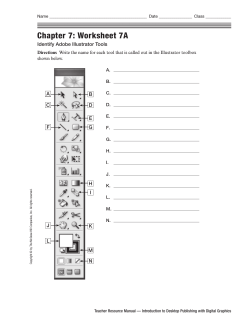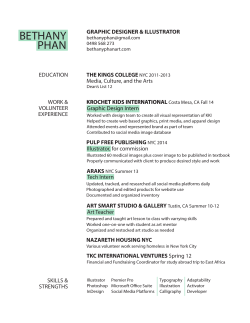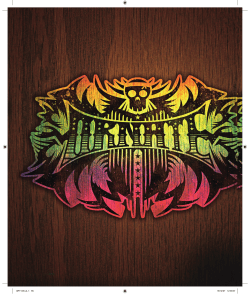
Portfolio
EDGAR ANZALDUA USER EXPERIENCE +61 423 628 325 DATA SCIENCE contact@eam.mx ANALYTICS blog.eam.mx eam.mx/twitter DATA VISUALIZATION eam.mx/linkedin Disclaimer: This portfolio must be used for the purpose intended upon its request and be treated as confidential. This portfolio must-not be re-distributed or published partially or in its entirety without express consent from the author, offenders may be prosecuted by the offended parties. All content is Copyrighted and belongs to either Edgar Alejandro Anzaldúa Moreno (the author) or it is used with authorization of Schneider Electric, eMedici or the people that appear in it. LONGSTORY SHORT When I joined the company the software looked dated, it was difficult to use, it was cluttered with conflicting features and lacked information architecture (IA) and task-oriented workflows. This particular screen would display several arbitrary pieces of information (some of it was redundant) and it was broken into 14 different sub-panels. We put together a cross-functional team that would collaboratively design interactions, IA and user interface. The team included people from Canada, Australia and Europe. Workshops lasted no more than 1.5 hours. Design ideas were consolidated into a single wireframe that later became a clickable prototype, which was pre-approved for technical feasibility, as members of the technical team co-designed it. Knowledge transfer was no longer required, everybody knew what was being being designed and why. Many of the elements of the screen went straight to the UI Pattern library, and some others helped build the application road-map (back-log). The result was a screen with reduced complexity and a sense of task-oriented flow, that talked to the user base without user-guides or training, that was easier to develop and with modular features that could be re-used. This modern-looking screen (considering Java Swing limitations) shows only 3 different panels and kept the same amount of information displayed, which reduced significantly code-base, bugs and maintenance cost. 0:00 AM 0:00 AM Last 6 Months 0:00 AM Last 6 Months Weight Last 6 Months BMI: 31.28 Fat % 110.2 Kg 29.8% Obese Class I (Moderately Obese) CHANGE: 5.28 MIN: 30.12 MAX: 35.4 CHANGE: 16.9 Kg MIN: 106.8 Kg MAX: 123.7 Kg iPad CHANGE: 8.2% MIN: 28.1% MAX: 36.3% 9:45 AM 100% Last 6 Months Weight BMI: 31.28 Fat % 110.2 Kg 29.8% Obese Class I (Moderately Obese) CHANGE: 16.9 Kg MIN: 106.8 Kg MAX: 123.7 Kg 123.7 Kg 11/11/2013 CHANGE: 5.28 MIN: 30.12 MAX: 35.4 CHANGE: 8.2% MIN: 28.1% MAX: 36.3% 110.2 Kg 18/02/2014 102.3 Kg 4/06/2014 Gordolytics http://eam.mx/portfolio GORDOLYTICS Edgar Anzaldua 12-Feb 13-Feb Responsive Design Weight 14-Feb 15-Feb 16-Feb Yesterday BMI: 31.28 110.2 Kg Today Tomorrow Fat % 29.8% Obese Class I (Moderately Obese) MIN: 106.8 Kg MAX: 123.7 Kg 123.7 Kg 11/11/2013 MIN: 30.12 MAX: 35.4 110.2 Kg 18/02/2014 MIN: 28.1% MAX: 36.3% 102.3 Kg 4/06/2014 MacBook Pro Personal Project: What started as a personal weight monitoring system spreadsheet in excel, derived into a fully fledged statistical and prediction model. Later on I added with the help of my friends multi-user support and developed a working prototype in Python, Javascript, CSS, HTML and D3. PORTFOLIO Process Design Companies get to where they are by following a process, whether they’re conscious of it or not. Successful companies are conscious of it and look for opportunities to improve it. I’ve had the opportunity to help define UX loops that enhance communication to make sure the right thing is delivered. The process below is an early version of the User Experience workflow that we followed at Schneider-Electric. User Experience Design Process Personas Vision, Framing and Outcomes Outcomes Features Hypothesis Statements Prototyping ssemble Hypothesis Statements no Start Feedback & Research Create Update Prototype Feedback UX Design Team yes Outcomes Personas no es Features Feature o Fidelity ire rame Hypothesis Statements Update Styleguide HC Veri y Standard End o Re ie Related Feedback Outcomes Personas Clickable Prototype Plan Tests Plan Tests es Declare Problem Statements Outcome rainstorming Session Persona rainstorming Session o Feature rainstorming Session Design Studio Session Sketch One on One One on One es Update Feature acklog Outcome Feature Sketches yes usiness orks heet Personas High Risk es Outcomes Features Familiar Client o Version 0.1 of a proposed UX process that would allow for collaborative design. Workshops (Collaborative Design) While I still produce design-work, my role has taken on the additional role of facilitator to lead teams through a series of exercises. The output of these sessions typically consists of low-fidelity sketches and wireframes. In Schneider-Electric, I’ve facilitated numerous collaborative problem discovery, risk assessment, design (called also design studios or charades), prioritization and development cycle planning (RPE) workshops with great success. They proved to bring people together, to make work more enjoyable and most importantly, they make sure the right thing gets built and that potential risks are discussed well before implementation. Moments from different design thinking workshops that I led at Schneider Electric. Complies Complies es One on One Complies Personas Feature Prioritization Models of the people for whom we believe we are solving the problem. Features are defined as the product changes or improvements that we believe will drive the outcomes we seek. Scope, Time and Budget affect the features included in the software are constantly competing forces while developing software, with quality often being compromised due to time or budget pressures. I’ve had the chance to create personas based on the target market of the application, and also a quicker version through empathetic and user-oriented thinking (which helps when resources are limited. Persona Definition Template 3. Personal Details 3.1 Role Name: __________________________________________ __________________________________________ __________________________________________ __________________________________________ __________________________________________ __________________________________________ __________________________________________ __________________________________________ __________________________________________ __________________________________________ __________________________________________ __________________________________________ __________________________________________ __________________________________________ __________________________________________ __________________________________________ 2. Context 2.2 Environment “ __________________________________________ __________________________________________ __________________________________________ __________________________________________ __________________________________________ __________________________________________ __________________________________________ “ 2013 Schneider Electric Pty. Ltd. Knowledge 4.1 Domain Poor L imited S tandard 1. ____________________________________ 2. ____________________________________ Good Great tandard Good 3. ____________________________________ 3.3 Goals: 1. ____________________________________ Great 0- 20 2. ____________________________________ 3. ____________________________________ 20+ 4.2 Technical (Software) Poor L imited S 4.3 Years of Experience 1–23 5. –55 - 10 1 Relationship with our Software 3.4 Motivations __________________________________________ __________________________________________ __________________________________________ __________________________________________ 5.1 Why use the software? __________________________________________ __________________________________________ __________________________________________ __________________________________________ 6 3.5 Risks 2.3 Form Factor: Copyright v1.0 Last Updated: 19/03/03 4. 3.2 Activities: 1.2 Back Story: Quote: Role Description 1.1 Name: __________________________________________ __________________________________________ __________________________________________ __________________________________________ __________________________________________ __________________________________________ __________________________________________ __________________________________________ __________________________________________ __________________________________________ __________________________________________ 5.1P rimary use of the Software __________________________________________ __________________________________________ __________________________________________ __________________________________________ 3.6 Frustrations or Pain Points __________________________________________ __________________________________________ __________________________________________ __________________________________________ 3.7 A Great Day __________________________________________ __________________________________________ __________________________________________ __________________________________________ Commercial-in-Confidence 5.1 Frequency of use Constantly Open 6. Twice a Day Once a Day Every other Day 5 Once a Week BEWARE! Anything Else? __________________________________________ __________________________________________ __________________________________________ __________________________________________ 4 Page 1 of 1 1 Persona Template and Sketch (2013) 2 Familiarity 3 4 Sketching 2 Paper/Whiteboard sketching will makes it easier for people to criticize solution are they are the cheap and fast to make. 1 I’ve been doing it for a long time. I tend to take photos from the whiteboard or scan paper sketches to keep notes on design decisions. 5 6 3 Technical Risk 1. By making teams collaboratively prioritize features, scope, time and budget should not compromise quality. In Schneider Electric, we use feature prioritization maps (kano/bang vs. buck) and risk assessments manage their expectations, making better and long-term relationships with them. Handdrawn/Balsamiq - Left: Progress Bar UI Pattern (Backlog) / Right:(2014) Risk Assessment Example. Wireframes Digital version of the sketches. Low-fidelity wireframes are rough, sizes, proportions and colors are approximate. High-fidelity wireframes can be used as guidelines for developers to build the software. I have experience designing both types of wireframes at different stages of my engagement with the SDLC. I’m tool agnostic, but I really like Balsamiq, Photoshop and Illustrator while designing. Hand Drawn Sketch - Design Studio Workshop - 2013 (above) Photoshop Wireframe - Advanced Planning and Scheduling, 2012 (above) Balsamiq Wireframe - Supply and Demand Optimization, 2014 (left) Illustrator Wireframe - General Purpose Dialog UI Pattern (Sizing), 2014 Dialog Title Content Dialog Title Content Dialog Title 6px Content 6px Horizontal Ruler: 2px 6px 6px 6px 6px 6px 6px The Progress Bar Dialog UI Pattern, is build on to the General Purpose Dialog UI Pattern. 355px 6px 30px Supply and Demand Optimization 6px 6px Operation Title: 20% 14px Task: Subtask: 1/n 1/m Cancel Supply and Demand Optimization Operation Title: Task: Subtask: 20% 1/n 1/m Cancel Supply and Demand Optimization Operation Title: Task: Subtask: 20% 1/n 1/m Cancel Supply and Demand Optimization Operation Title: Task: Subtask: 20% 1/n 1/m Cancel Illustrator Wireframe - Progress Bar Dialog UI Pattern (Sizing), 2014 Paper Prototype Technical Storyboarding A low cost alternative for Formative Testing that allows UX researchers to get ready for Summative Testing consisting of easily movable and replaceable interface elements created from pieces of paper. Not as high-level as the traditional one, Technical Storyboarding allows step by step Human-Computer Interaction analysis. This quick approximation, has helped me identifying and fixing potential interaction flaws, as they are fast to amend and people in the team are more open to criticize this work rather than the finished realistic design comp. Paper Prototype for a Window Based Application, 2015 This has proven to be a great tool to document interactions between the user and the system and communicate to developers. I’ve found this very useful as an input for writing technical specifications. Balsamiq - Technical Storyboard, 2014 Clickable Prototype A deliverable that will help communicating all the design work that has been done so far without boring people with pages and pages of explanation. In my experience at Schneider-Electric and as a consultant, I’ve found that making clickable prototypes would set the right expectation on the customer’s mind on what is to be delivered, and provides a final feedback look back to the customer for further refinement. Adobe Acrobat, Clickable PDF Prototype, 2014 FACILITATION TOOLS Prioritizing Context Understanding the context in which a software application is used is critical for its success and adoption. I designed the following card deck to help the leadership team at Hostworks understand and set the target context priority of the application that we are developing. Accompanying documentation helped further understand each context. IN MOTION HOME ACE WORKPL ///// HOME HOME IN MOTION AT WORK AT HOME AT HOME AT WORK HOME COMPUTER ER / COMPUTER + TV COMPUT COMPUTER ///// + TABLET TABLET + TV / TABLET / + TABLET SMARTPHONE + TV IN MOTION SMARTPHONE SMARTPHONE SMARTPHONE ///// + Illustrator, Premium Gaming Plastic, 2015 - Among other benefits that following this technique gave us, was that there wasn’t a clear understanding of the vision of the software. This quick, cheap and humbling approach allows teams to be more introspective about being working towards similar goals. Storyboards A higher-level storyboard allows organizations to find design gaps or come up with ideal scenarios in which the application being developed has reached maturity. Vectorizing these assets and keeping a digital copy allows me to reuse assets Storyboard T itle: Cre ate a Series, Season quicker and to enhance sketches with effects. e and Episode Struct Project: ure Platform Author: EdgarA@Host Works.com.au Date: 14/5/2015 From Scratch Remind me L ater (4.1.1) Start the Series Man agement Feature and Create a Series (4.1.2) and fill in the detail. (4.1.3) Create a Season and V app ityTdeta in the il. Notaku opens the Comfillmun in his phone. (4.1.6 and 4.1.7) Make sure the "add new episode when finished" checkbox is ticked and repe at, and untick when the last episode has been added to the seas on. (4.1.8) Add Another Season if Required by going "up the tree" two levels. t there’s a banner Once open, he notices tha highlights. show that indicates upcoming (4.1.4 and 4.1.5) Create an Episode and Fill in the Det ail. (4.1.8) Repeat from 4.1.3 until no more seaso ing World Cup He taps excited on the Fish s two weeks it’ t tha ices banner and not ahead. has been completed the EXPERTISE MAPPING Timeline Programming & Markup Lang. 2011 2010 2009 2008 2007 2006 2005 2004 2003 2001 Frameworks D3 JQuery DJango Rails Highcharts Bootstrap Ratchet Workplaces and Education 2000 1999 1998 PROMOTIONS SENIOR / LEADER 2002 ENTRY LEVEL XHTML CSS Java SE Javascript Python Ruby PHP JSON & XML 2012 PROFESSIONAL EXPERIENCE Photoshop Illustrator Indesign Fireworks Dreamweaver Google Analytics Google Adwords Balsamiq Mockups Omnigraffle Netbeans Eclipse 2013 MASTER OF SCIENCE Tools 2014 - PRESENT EDUCATION Design Thinking Heuristic Evaluation Workshop Leading User Research Personas Sketching Collaborative Design Wireframing Storyboarding Prototyping User Testing Information Architecture Big Data & Analytics Design Strategy User Interface Design Visual Design BACHELOR OF SCIENCE Design MORE Logo Design FC OI VN SE U DL TO I GN SG Five Dogs Consulting, 2010 Nortel’s Green Team, 2008 Latin American Airport Holding, 2006 Book Design Broadband Telecommunications Technologies and Management Book, 2014 CMU Yearbook, 2010 Photography Left: Angel de la Independencia (2007) / Top: Chiapas, Mexican Jungle (2009) / Right: Dorste Self-Portrait (2008); Center-Down-Left: Me @ Flickr Exhibition (2007) / Center-Down-Right: Me @ Public Exhibition (2009) Publications MUST READ Left: Book El Mexico de los Mexicanos (Mexican’s Mexico) / Center: Muestra tu México en Flickr (Show Your Mexico in Flickr) Yahoo’s Commemorative Book / Right: Data Mining / Information Visualization Research Paper 3D Modelling Selft Portrait, Cinema 4D (2013) Mexican-Australian, Cinema 4D(2014) 3D Video 3D Presentation for Mexican Government, Cinema 4D, Photoshop, Illustrator and Final Cut (2007) http://youtu.be/80WhhbBcoF4 Friend’s Proposal Video, Cinema 4D, Photoshop, Illustrator and Final Cut (2007) http://youtu.be/OoA8arpncTQ MUST WATCH Video Production Intro Scene for Five Dogs Media, Soundtrack, Photoshop, Illustrator and Final Cut (2011) http://youtu.be/juLKdQ5ttHA The Making of the Greatest Software Ever, Final Cut (2011) http://youtu.be/ZL39xb3z4tY Just Fun!
© Copyright 2025









